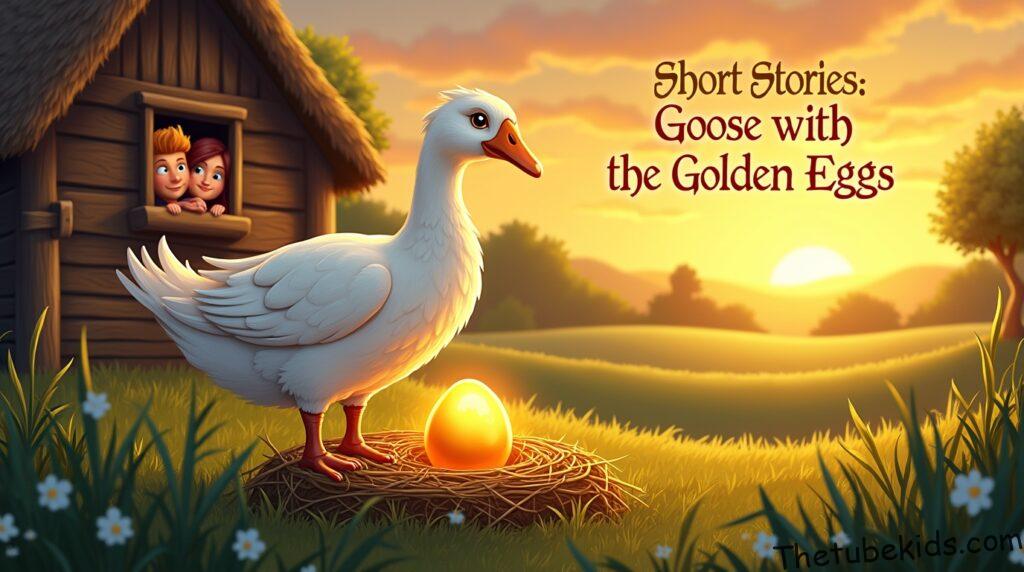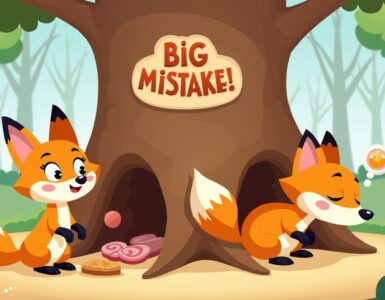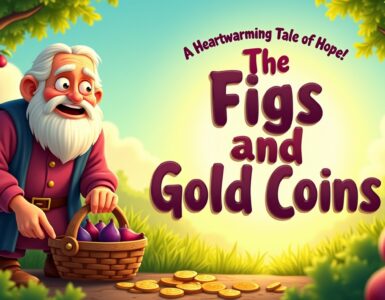Once upon a time, a man and his wife had the good fortune to have a goose which laid a golden egg every day. Lucky though they were, they soon began to think they were not getting rich fast enough.
They imagined that if the bird is able to lay golden eggs, its insides must be made of gold. And they thought that if they could get all that precious metal at once, they would get mighty rich very soon. So the man and his wife decided to kill the bird.
However, upon cutting the goose open, they were shocked to find that its innards were like that of any other goose!
MORAL: Greed can lead to loss; be content with what you have.
More: Short Stories: Love and The Time Story
Short Stories The Goose with the Golden Eggs
Short Stories The Goose with the Golden Eggs is one of the most enduring fables from Aesop’s collection, captivating audiences for centuries with its simple yet profound narrative. This classic tale tells the story of a farmer who discovers a goose that lays golden eggs, only to let greed destroy his good fortune. As an expert in literary analysis and folklore, I’ll delve into this fable’s rich history, moral teachings, and real-world applications, drawing on its themes to offer insights that resonate even today.
The Historical Roots of Short Stories: The Goose with the Golden Eggs
Delving into the origins of classic fables like Short Stories The Goose with the Golden Eggs reveals how timeless stories shape cultural identities and moral frameworks. This fable, attributed to Aesop, a storyteller from ancient Greece, has roots that stretch back over 2,500 years. It’s fascinating to explore how such narratives have been preserved and adapted across civilizations, influencing literature, art, and education. As an expert, I draw on historical texts and scholarly analyses to uncover the layers of meaning embedded in this tale, highlighting its evolution from oral tradition to written word.
The Authorship and Ancient Origins
The story of The Goose with the Golden Eggs is most commonly linked to Aesop, a figure shrouded in legend from 6th century BCE Greece. Aesop is believed to have been a slave who used fables to convey wisdom, and this particular tale exemplifies his style—short, allegorical, and packed with moral punch. Historical records, such as those in Herodotus’s writings, suggest that Aesop’s stories were circulated orally before being compiled in collections like the Aesopica. This fable likely drew from earlier mythological motifs, such as those in Greek myths where magical animals symbolize abundance or folly.
What makes Short Stories The Goose with the Golden Eggs so enduring is its universal appeal. The narrative centers on a farmer who finds a goose laying golden eggs, representing sudden wealth. Driven by greed, he kills the goose to access more riches, only to find nothing inside. This plot device isn’t unique to Aesop; similar themes appear in ancient Indian Panchatantra tales and Roman literature, indicating a cross-cultural exchange of ideas. As a literary expert, I emphasize that Aesop’s version stands out for its concise structure and clear moral, making it a cornerstone of Western fable tradition.
In medieval Europe, the story was adapted in illuminated manuscripts and moralistic texts, often illustrated to teach children about the dangers of avarice. By the Renaissance, it appeared in printed books, solidifying its place in canon. Today, scholars like Laura Gibbs in her work on Aesop’s fables analyze how this story reflects economic anxieties in ancient societies, where wealth was precarious. Understanding these roots helps us appreciate how Short Stories The Goose with the Golden Eggs has transcended time, offering insights into human nature that remain relevant.
Evolution Through Different Cultures
Over centuries, The Goose with the Golden Eggs has been reinterpreted in various cultural contexts, adapting to local values while retaining its core message. In Asia, for instance, similar folktales in Chinese and Japanese traditions feature magical creatures that punish human greed, showing how the fable’s themes resonate globally. During the Enlightenment, European writers like Jean de La Fontaine retold Aesop’s stories, infusing them with wit and social commentary, which helped spread the tale to new audiences.
This evolution highlights the fable’s flexibility. In Victorian England, it was used in children’s education to instill fiscal responsibility, often with illustrations that exaggerated the farmer’s folly. In modern times, adaptations in films and animations, such as those by Disney, have made Short Stories The Goose with the Golden Eggs accessible to younger generations, though sometimes softening its harsh moral. As an authority on folklore, I note that these changes reflect societal shifts—from agrarian economies to consumer-driven cultures—yet the warning against overreaching ambition stays constant.
Cultural adaptations also reveal how the story addresses contemporary issues. In postcolonial literature, it might symbolize exploitative colonialism, where short-term gains lead to long-term loss. This cross-cultural journey underscores the fable’s genius: it’s not just a story but a mirror for human behavior, continually reimagined to fit new eras.
Significance in Literature and Education
Short Stories The Goose with the Golden Eggs holds a pivotal place in literary history, serving as a model for concise storytelling and moral instruction. Its influence extends to writers like George Orwell, who drew on fable-like structures in works such as Animal Farm. In education, the tale is a staple in curricula worldwide, teaching critical thinking and ethics through simple narratives. Teachers often use it to spark discussions on greed and sustainability, making it a tool for character development.
From a scholarly perspective, the fable’s significance lies in its role in the bildungsroman tradition, where characters learn from mistakes. Experts like Maria Tatar in her studies on fairy tales argue that such stories help children navigate moral complexities. In adult contexts, it’s referenced in business ethics courses, illustrating the pitfalls of short-sighted decisions. This dual appeal—educational and entertaining—cements its legacy as a literary gem.

Unpacking the Moral: Lessons from The Goose with the Golden Eggs
At the heart of Short Stories The Goose with the Golden Eggs lies a powerful moral about the consequences of greed, a theme that has echoed through history. This fable isn’t just a quaint tale; it’s a profound commentary on human nature, warning against the destructive force of unchecked desire. As an expert in moral philosophy and literature, I’ll explore how this story imparts timeless lessons, drawing on psychological insights and real-world examples to show why it remains relevant. Greed, as depicted here, can lead to self-sabotage, a concept that applies to personal finances, relationships, and even global issues like environmental depletion.
The Core Moral: Greed and Its Downfall
The central lesson of The Goose with the Golden Eggs is crystal clear: haste and avarice can destroy sources of genuine prosperity. The farmer, content at first with one golden egg a day, succumbs to greed and kills the goose, only to lose everything. This narrative arc serves as a cautionary tale, emphasizing that sustainable wealth comes from patience and wise management, not impulsive actions.
In psychological terms, this mirrors concepts like the “endowment effect,” where people overvalue what they have and risk it for more. Studies in behavioral economics, such as those by Daniel Kahneman, support this idea, showing how greed can cloud judgment. For instance, in modern scenarios, investors might sell off stable assets for quick profits, only to face losses—much like the farmer’s fatal mistake.
By examining this moral, we see how Short Stories The Goose with the Golden Eggs teaches contentment and foresight. It’s a reminder that true success often lies in appreciating what we have, rather than always seeking more. This lesson is particularly poignant in today’s consumerist society, where instant gratification is the norm.
Psychological Insights and Character Analysis
Delving deeper, the characters in this fable represent archetypal human flaws. The farmer embodies the everyman, whose initial gratitude turns to hubris, illustrating how greed can corrupt even the most ordinary individuals. Psychologists like Sigmund Freud might interpret this as a struggle between the id (impulsive desires) and the ego (rational self), with the farmer’s downfall resulting from unchecked impulses.
Real-world examples abound: consider historical figures like King Midas, whose golden touch curse parallels this story, or modern cases like corporate scandals where executives prioritize short-term gains over long-term stability. These parallels highlight the fable’s psychological depth, showing how greed often stems from insecurity ordesires for validation, leading to disastrous consequences.
In analyzing the farmer’s character, we also see a reflection of societal pressures. In many cultures, wealth is equated with success, creating an environment where individuals feel compelled to pursue constant growth and material gain without considering the repercussions. This relentless pursuit can lead to burnout, dissatisfaction, or even ethical compromises. By framing the narrative through psychology, we glean deeper insights into how greed manifests not just personally but also collectively within communities and economies.
Real-World Applications: Lessons from the Fable
The beauty of Short Stories The Goose with the Golden Eggs lies in its applicability to modern life. From personal finances to corporate strategies, the fable offers a lens through which we can examine our values and decisions. In personal finance, for instance, the story serves as a powerful reminder to prioritize saving and responsible investing over impulsive spending. Many financial advisors echo this sentiment, advocating for long-term investment strategies rather than chasing after fleeting market trends or get-rich-quick schemes.
In the corporate realm, businesses can draw parallels to this tale when considering their growth strategies. Companies that focus solely on short-term profits—often at the expense of sustainable practices or employee well-being—risk jeopardizing their future viability. A classic example would be corporations that exploit natural resources without regard for environmental sustainability, mirroring the farmer’s fate when he sacrificed the goose for immediate riches.
Moreover, the moral lessons embedded within this fable can be utilized in discussions surrounding global issues like climate change. As societies grapple with the consequences of unsustainable practices, the themes of patience and foresight found in The Goose with the Golden Eggs urge us to rethink our approach to consumption and production, advocating for a balance between immediate desires and long-term sustainability.
FAQs
What is the main lesson of The Goose with the Golden Eggs?
The primary lesson revolves around the dangers of greed. The fable illustrates that hasty actions motivated by avarice can lead to significant losses. It emphasizes the importance of patience, careful management, and contentment with what one already possesses.
How has The Goose with the Golden Eggs been adapted across cultures?
The fable has seen numerous adaptations, reflecting various cultural values and morals. In Eastern folklore, similar tales often feature magical creatures punishing human greed, while Western interpretations have included social critiques. Each retelling maintains the core message while offering localized insights.
Why is The Goose with the Golden Eggs important in educational contexts?
The fable serves as an effective tool for teaching critical thinking and ethical behavior. It introduces complex moral dilemmas in a simple format, making it accessible for discussions about greed, responsibility, and decision-making in both children and adults.
Can you provide examples of modern parallels to the fable?
Modern parallels include instances of corporate scandals where executives prioritize short-term gains over long-term stability and environmental sustainability. Additionally, individual cases of financial mismanagement due to impulsive investments also mirror the farmer’s downfall.
How can individuals apply lessons from The Goose with the Golden Eggs in their lives?
Individuals can embrace the fable’s teachings by practicing patience in financial decisions, valuing what they have rather than chasing after more, and striving for sustainable practices in personal and professional realms. It encourages a mindset shift towards appreciation and long-term planning.
The enduring appeal of Short Stories The Goose with the Golden Eggs lies in its powerful moral about greed and the ramifications of unchecked desire. Through its various adaptations and relevance in different contexts, the fable continues to impart valuable lessons about patience, sustainability, and the importance of thoughtful decision-making. As readers explore its timeless themes, they are reminded that true prosperity comes not from instant gratification but from nurturing what we have and making wise choices for the future.
More: Bedtime Stories

















